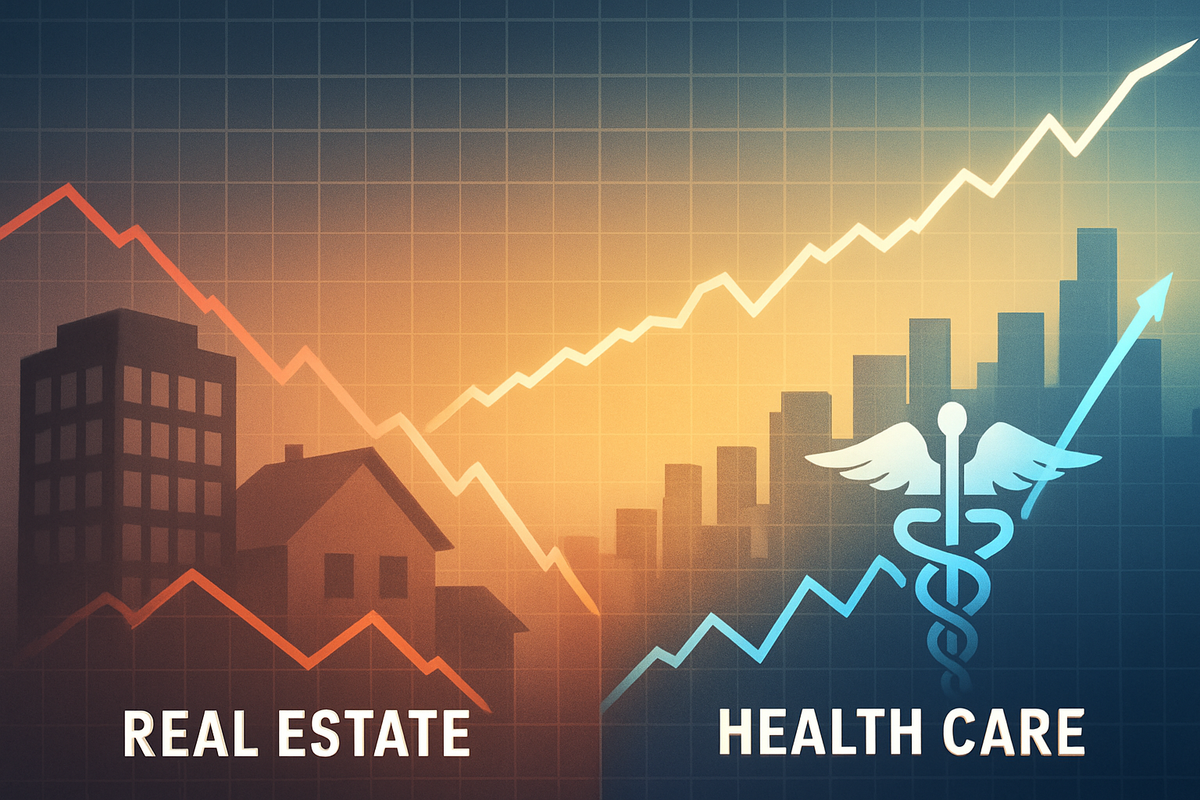Financial News
Divergent Paths: Real Estate Stumbles While Healthcare Shines Amidst S&P 500's Record Ascent

As the S&P 500 and Nasdaq Composite continue their relentless climb to uncharted record highs in early October 2025, a fascinating and somewhat contradictory narrative is unfolding within the traditionally stable defensive sectors. While the broader market celebrates robust gains, propelled largely by the technology and artificial intelligence boom, the defensive cohort presents a bifurcated picture: the Real Estate sector is conspicuously lagging, extending a period of underperformance, while the Healthcare sector has surprisingly surged, emerging as a beacon of stability and growth. This stark divergence challenges conventional wisdom about safe-haven assets and signals a complex interplay of investor sentiment, policy shifts, and macroeconomic factors.
This unusual market dynamic highlights a selective "risk-on" appetite among investors, who are pouring capital into high-growth areas, yet simultaneously seeking specific havens within defensive plays. The underperformance of Real Estate, often seen as a bond proxy, underscores its acute sensitivity to interest rates, even as the Federal Reserve hints at a dovish pivot. Conversely, Healthcare's unexpected rally suggests that sector-specific catalysts, such as policy clarity and inelastic demand, can override broader market trends, painting a nuanced landscape for investors navigating the current bull market.
A Tale of Two Defensives: Real Estate's Struggle vs. Healthcare's Ascent
The opening days of October 2025 have delivered a compelling contrast in the performance of defensive sectors. On one hand, the S&P 500 Real Estate (XLRE) sector has continued its struggle, recording a -0.22% month-to-date (MTD) return as of October 3, 2025, and a -5.59% return over the past year. This extends a trend observed throughout 2024, where Real Estate Investment Trusts (REITs) delivered a modest 8.8% positive return, significantly trailing the S&P 500's 25.0% and the Nasdaq's 29.6%. Reports on October 6, 2025, explicitly noted that "tech was by far the top performing sector while real estate lagged," reinforcing its position as a market laggard. This underperformance is primarily attributed to its high sensitivity to interest rates, which have kept the housing market "frozen" through much of 2025.
In stark contrast, the Healthcare sector (XLV) has defied its traditional "defensive" categorization by exhibiting remarkable strength. On October 1, 2025, healthcare stocks collectively surged by an impressive 5.4%, marking their most significant one-day percentage gain since November 2008. This momentum carried through the week, with healthcare stocks leading gains by rising 6.6% by October 5, 2025. The S&P 500 Pharmaceuticals Index, a key sub-segment, jumped 10.8% in the week leading up to October 3, its strongest performance since July 2002. This sudden outperformance is a dramatic turnaround from 2024, when the sector underperformed as investors flocked to high-growth tech. A landmark drug pricing agreement involving Pfizer Inc. (NYSE: PFE) with the White House, providing policy clarity and optimism, is cited as a significant catalyst.
Meanwhile, the broader market indices have continued their upward trajectory, seemingly unfazed by the mixed signals from defensive plays. The S&P 500 (NYSEARCA: SPY) closed 0.3% higher on October 1, setting a new closing high, with the Nasdaq Composite (NASDAQ: QQQ) rising 0.4%, approaching its own records. By October 6, both the S&P 500 and Nasdaq 100 extended record closes, rising 0.4% and 0.8% respectively, primarily fueled by AI-related dealmaking and investor enthusiasm for technology giants. This environment of robust overall market growth, juxtaposed with the distinct performances within defensive sectors, creates a complex and intriguing investment landscape.
Winners and Losers in a Bifurcated Market
The current market environment, characterized by strong broad market performance and divergent trends within defensive sectors, creates clear winners and losers across various industries.
On the losing side, companies within the Real Estate sector are feeling the most significant pressure. Real Estate Investment Trusts (REITs) that are highly sensitive to interest rates, such as those focused on office spaces, traditional retail, and even residential segments, continue to face headwinds. Higher borrowing costs, even with anticipated easing, and a subdued transaction environment have impacted their profitability and growth prospects. While some niche areas like data centers and logistics might show resilience, the broader sector remains challenged. For example, major commercial real estate developers and operators, whose valuations are tied to property income and debt costs, are struggling to keep pace with the broader market's gains.
Conversely, the Healthcare sector's recent surge has created significant winners. Pharmaceutical companies, particularly those involved in recent policy agreements or with strong drug pipelines, are experiencing renewed investor confidence. Pfizer Inc. (NYSE: PFE), for instance, benefited directly from the landmark drug pricing agreement, seeing its stock price respond positively. Biotechnology firms, especially those at the forefront of gene therapies and other innovative treatments, are also attracting substantial investment, driven by the promise of future breakthroughs and inelastic demand for their products. Medical device manufacturers and healthcare service providers, which benefit from consistent demand regardless of economic cycles, are also enjoying the sector's newfound momentum.
Beyond the defensive sectors, the broader market's record highs are largely driven by the Technology sector and companies heavily invested in Artificial Intelligence. Tech giants such as Apple Inc. (NASDAQ: AAPL), Microsoft Corporation (NASDAQ: MSFT), and Nvidia Corporation (NASDAQ: NVDA) continue to be major beneficiaries, as investor enthusiasm for AI innovation and robust earnings reports fuel their growth. These companies, along with other high-growth firms, are attracting capital that might otherwise flow into traditional safe havens, further contributing to the divergence observed in the defensive sectors. This dynamic suggests that investors are increasingly selective, rewarding companies with strong growth narratives and clear catalysts, while being more discerning with those facing macroeconomic headwinds.
Wider Significance and Historical Context
This intriguing divergence within the defensive sectors, set against a backdrop of record-breaking broader market performance, carries wider significance for industry trends, policy implications, and historical parallels. The strong performance of the S&P 500 and Nasdaq, primarily driven by technology and AI, solidifies a "risk-on" sentiment where investors prioritize growth and innovation. This trend, which began in earnest in 2024, continues to funnel capital into companies perceived as future leaders, potentially at the expense of sectors with less exciting growth prospects or higher sensitivity to macroeconomic shifts.
The Real Estate sector's continued underperformance underscores its profound vulnerability to interest rate fluctuations. Even with the U.S. Federal Reserve initiating an easing cycle in September 2025, the impact on mortgage rates and property valuations is gradual. This highlights a broader industry trend where rising cost of capital disproportionately affects capital-intensive sectors. Historically, real estate often lags during periods of monetary tightening and takes time to recover even when rates begin to fall. This current lag could signal a prolonged period of adjustment for the sector, requiring strategic pivots towards more resilient asset classes like logistics or specialized healthcare real estate, which have shown pockets of strength.
Conversely, Healthcare's unexpected outperformance, transforming from a defensive laggard in 2024 to a market leader in early October 2025, reveals the critical role of sector-specific catalysts. The landmark drug pricing agreement involving Pfizer Inc. (NYSE: PFE) demonstrates how policy clarity and favorable regulatory environments can significantly boost investor confidence, even in an otherwise cautious market. This event could set a precedent, indicating that targeted policy initiatives can unlock value and drive growth in sectors often weighed down by regulatory uncertainty. From a historical perspective, defensive sectors typically shine during economic downturns or periods of high uncertainty. Healthcare's current rally, amidst a strong bull market, suggests a unique confluence of defensive characteristics (inelastic demand) and growth catalysts (innovation, policy support). This deviates from a simple "risk-off" narrative, indicating a more nuanced investment landscape where specific sub-sectors can thrive independently.
What Comes Next: Navigating a Complex Market
Looking ahead, the market is poised for continued complexity, with short-term and long-term implications for investors, companies, and strategic decision-making. In the short term, the Real Estate sector is likely to remain under pressure, although the anticipated easing of interest rates by the U.S. Federal Reserve could provide a gradual tailwind. Investors will be closely watching for further rate cuts and their tangible impact on mortgage rates and commercial property valuations. Any significant slowdown in the broader economy, however, could exacerbate real estate's woes, as demand for new construction and commercial spaces typically wanes during such periods. Real estate companies may need to focus on debt management, portfolio optimization, and divesting non-core assets to weather potential volatility.
For the Healthcare sector, the outlook appears more robust in both the short and long term. The momentum gained from recent policy clarity and sustained investor interest in innovation, particularly in biotechnology and pharmaceuticals, is expected to continue. The inelastic demand for healthcare services and products provides a fundamental floor, making it an attractive sector during periods of broader market uncertainty. Companies in this sector will likely continue to invest heavily in research and development, seeking to capitalize on advancements in areas like gene therapy and personalized medicine. However, potential future regulatory shifts or renewed debates over drug pricing could introduce headwinds, requiring companies to maintain agile policy engagement strategies.
The broader market's trajectory will largely depend on the sustained performance of the technology sector and the continued enthusiasm for Artificial Intelligence. As long as earnings remain strong and innovation continues, the S&P 500 and Nasdaq are likely to maintain their upward momentum. However, any signs of an AI bubble or a broader economic slowdown could lead to a significant market correction. This environment presents both opportunities and challenges: opportunities for investors to capitalize on high-growth areas, but also challenges in identifying genuinely sustainable growth versus speculative bubbles. Strategic pivots for companies across all sectors will involve assessing their exposure to AI, their resilience to interest rate changes, and their ability to innovate and adapt to evolving consumer and regulatory landscapes.
A Nuanced Market: Resilience, Lag, and Record Highs
The early days of October 2025 paint a picture of a financial market that is anything but uniform. While the S&P 500 and Nasdaq Composite indices confidently chart new record highs, largely propelled by the effervescence of the technology and AI sectors, the performance within the traditionally defensive segments reveals a nuanced and often contradictory narrative. The Real Estate sector continues to grapple with significant headwinds, primarily stemming from its acute sensitivity to interest rates, extending a period of underperformance that began in 2024. This persistent lag serves as a critical reminder of how macroeconomic policies can disproportionately impact capital-intensive industries, even amidst a generally bullish market.
In stark contrast, the Healthcare sector has emerged as an unexpected leader, demonstrating remarkable resilience and even outperformance. Fueled by a combination of defensive characteristics, robust innovation in biotechnology, and crucial policy clarity such as the Pfizer Inc. (NYSE: PFE) drug pricing agreement, Healthcare has defied expectations, attracting substantial investor interest. This divergence underscores that "defensive" is not a monolithic label; rather, sector-specific catalysts and fundamental strengths can drive unique trajectories, even when broader market sentiment leans towards risk-on.
Moving forward, investors should closely monitor the Federal Reserve's monetary policy, particularly the pace and extent of future interest rate cuts, as these will be pivotal for the Real Estate sector's potential recovery. Simultaneously, keeping an eye on advancements in AI and the earnings reports from major technology companies will be crucial for gauging the sustainability of the broader market rally. For the Healthcare sector, watch for continued innovation, further policy developments, and any shifts in the regulatory landscape that could impact pharmaceutical and biotech companies. The market's current state is a testament to its dynamic nature, where broad trends coexist with intricate sector-specific narratives, demanding a discerning and adaptable investment approach.
This content is intended for informational purposes only and is not financial advice
More News
View More





Quotes delayed at least 20 minutes.
By accessing this page, you agree to the following
Privacy Policy and Terms Of Service.



